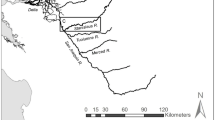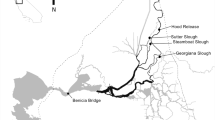Abstract
Survival of juvenile fall-run Chinook Salmon Oncorhynchus tshawytscha from the San Joaquin River (SJR) during their migration through the Sacramento-San Joaquin Delta of California has been low in recent years, and there is uncertainty about the role of river flow on survival. Five years (2010–2014) of acoustic telemetry data from juvenile hatchery-reared salmon offer spatially detailed survival information through this region. Multinomial regression and generalized linear models were used to relate survival to river flow in the SJR and its distributary, Old River (OR), on various spatial and temporal scales. Higher survival to Delta exit (rkm 77 from Golden Gate Bridge) was associated with higher root mean square of OR flow in the strongly tidal interior Delta (rkm 123; P < 0.0001), but not with higher SJR flow either entering the Delta from upstream (rkm 196; P = 0.2795) or measured in the Delta near the riverine/tidal interface (rkm 150; P = 0.3845). Survival in the upstream, more riverine region of the Delta was positively associated with SJR flow measured at rkm 150 and average net flow in the interior Delta (P ≤ 0.0001 for each), suggesting different mechanisms driving survival in the upstream versus downstream reaches of the Delta. The spatial complexity of the survival-flow relationship suggests that efforts to maximize total Delta survival should focus on a sequence of smaller regions, tailoring management strategies to each region rather than a single strategy for the Delta as a whole. Highly variable environmental conditions in this region combined with very low survival require more data to fully address the complex survival-flow relationship, both more years of data on various spatial scales and larger sample sizes of acoustic-tagged fish.








Similar content being viewed by others
References
Adams NS, Rondorf DW, Evans SD, Kelly JE (1998) Effects of surgically and gastrically implanted radio tags on growth and feeding behavior of juvenile Chinook Salmon. Trans Am Fish Soc 127:128–136
Anderson JJ, Gurarie E, Zabel RW (2005) Mean free-path length theory of predator–prey interactions: application to juvenile salmon migration. Ecol Model 186(2):196–211
Bowen MD, Bark R (2012) 2010 effectiveness of a non-physical fish barrier at the divergence of the Old and San Joaquin Rivers (CA). Bureau of Reclamation, Technical Service Center, Denver. Technical memorandum 86–68290–10-07. U.S.
Brandes PL, McLain JS (2001) Juvenile Chinook salmon abundance, distribution, and survival in the Sacramento-San Joaquin estuary. In: Brown, RL (2001) Fish Bulletin 179(2):39-136. Contributions to the Biology of Central Valley Salmonids. Retrieved from https://escholarship.org/uc/item/6sd4z5b2. Accessed 24 Oct 2019
Buchanan R, Brandes P, Marshall M, Foott JS, Ingram J, LaPlante D, Israel J (2015) 2012 South Delta Chinook salmon survival study. Available: https://www.fws.gov/lodi/salmonid_survival_studies/juvenile_salmonid_survival_reports.htm. Accessed 19 Nov 2018
Buchanan R, Brandes P, Marshall M, Nichols K, Ingram J, LaPlante D, Israel J (2016) 2013 South Delta Chinook salmon survival study. Ed. Brandes P. Available: https://www.fws.gov/lodi/salmonid_survival_studies/juvenile_salmonid_survival_reports.htm. Accessed 19 Nov 2018
Buchanan R, Brandes P, Ingram J, Marshall M, Nichols K, LaPlante D, Barnard D, Towne K, Israel J (2018a) 2014 South Delta Chinook Salmon survival study. Ed. Brandes P. Available: https://www.fws.gov/lodi/salmonid_survival_studies/juvenile_salmonid_survival_reports.htm. Accessed 19 Nov 2018
Buchanan RA, Brandes PL, Skalski JR (2018b) Survival of juvenile fall-run Chinook Salmon through the San Joaquin River Delta, California, 2010-2015. N Am J Fish Manag 38:663–679
Burnham KP, Anderson DR (2002) Model selection and multimodel inference: a practical information-theoretic approach, 2nd edn. Springer, New York
California Department of Fish and Wildlife (CDFW) (2019) GrandTab California Central Valley Chinook Salmon Population Database. Accessed via www.wildlife.ca.gov/Conservation/Fishes/Chinook-Salmon/Anadromous-Assessment on July 31, 2019
Cavallo B, Gaskill P, Melgo J (2013) Investigating the influence of tides, inflows, and exports on sub-daily flow in the Sacramento-San Joaquin Delta. Available: www.researchgate.net/publication/329075645_Investing_the_influence_of_tides_inflows_and_exports_on_sub-daily_flows_in_the_Sacramento-San_Joaquin_Delta. Accessed 20 Nov 2018
Fisher FW (1994) Past and present status of Central Valley Chinook Salmon. Conserv Biol 8:870–873
Holbrook CM, Perry RW, Brandes PL, Adams NS (2013) Adjusting survival estimates for premature transmitter failure: a case study from the Sacramento-San Joaquin Delta. Environ Biol Fish 96:165–173
Hosmer DW, Lemeshow S (2000) Applied logistic regression, 2nd edn. Wiley, New York
Hutton P (2008) A Model to estimate combined Old and Middle river flows. Metropolitan Water District. 90 pp. Available: https://www.baydeltalive.com/docs. Accessed 19 Nov 2018
Jonsson N (1991) Influence of water flow, water temperature and light on fish migration in rivers. Nord J Freshw Res 66:20–35
Liedtke TL, Beeman JW, Gee LP (2012) A standard operating procedure for the surgical implantation of transmitters in juvenile salmonids: U.S. Geological Survey Open-File Report 2012–1267, 50 pp
Martinelli TL, Hansel HC, Shively RS (1998) Growth and physiological responses to surgical and gastric radio tag implantation techniques in subyearling Chinook Salmon. Hydrobiologia 371/372:79–87
McCormick SD, Hansen LP, Quinn TP, Saunders RL (1998) Movement, migration, and smolting of Atlantic salmon (Salmo salar). Can J Fish Aquat Sci 55(Suppl. 1):77–92
McCullagh P, Nelder J (1989) Generalized linear models, 2nd edn. Chapman and Hall, London
Michel CJ, Ammann AJ, Lindley ST, Sandstrom PT, Chapman ED, Thomas MJ, Singer GP, Klimley AP, MacFarlane RB (2015) Chinook salmon outmigration survival in wet and dry years in California’s Sacramento River. Can J Fish Aquat Sci 72:1749–1759
Nam B-H, D’Agostino RB (2002) Discrimination index, the area under the ROC curve. In: Huber-Carol C, Balakrishnan N, Nikulin MS, Mesbah M (eds) Goodness-of-fit tests and model validity. Birkhauser Verlag, Boston, ch 20
National Oceanographic and Atmospheric Administration (NOAA) (2008) Fisheries off West Coast states and in the Western Pacific: West Coast salmon fisheries; 2008 management measures and a temporary rule. 50 CFR Part 660, Docket No. 080428611–8612-01 RIN 0648-AW60. U.S. Federal Register 73:85 (May 1, 2008):23974. Available: http://www.pcouncil.org/wp-content/uploads/E8-9687.pdf. Accessed 19 Nov 2018
National Oceanographic and Atmospheric Administration (NOAA) (2009a) Fisheries off West Coast states and in the Western Pacific: West Coast salmon fisheries; 2009 management measures. 50 CFR Part 660, Docket No. 090324366–9371-01 RIN 0648-AX81. U.S. Federal Register 74:85(May 5, 2009):20613. Available: http://www.pcouncil.org/wp-content/uploads/E9-10308.pdf. Accessed 19 Nov 2018
National Oceanographic and Atmospheric Administration (NOAA) (2009b) (amended 2011) Endangered Species Act Section 7 consultation: Biological opinion and conference opinion on the long-term operations of the Central Valley Project and State Water Project. June 4, 2009, amended April 7, 2011. Available: https://www.westcoast.fisheries.noaa.gov/central_valley/water_operations/ocap.html. Accessed 19 Nov 2018
National Oceanographic and Atmospheric Administration (NOAA) (2017) Endangered Species Act Section 7(a)(2) biological opinion, Magnuson-Stevens Fishery Conservation and Management Act Essential Fish Habitat Response, and Fish and Wildlife Coordination Act Recommendations for the California WaterFix Project in Central Valley, California. June 16, 2017. Available: https://www.westcoast.fisheries.noaa.gov/central_valley/CAWaterFix.html. Accessed 19 Nov 2018
Newman KB (2003) Modelling paired release–recovery data in the presence of survival and capture heterogeneity with application to marked juvenile salmon. Stat Model 3:157–177
Newman, KB (2008) An evaluation of four Sacramento-San Joaquin River Delta juvenile salmon survival studies. 182 pp. Available: https://www.science.calwater.ca.gov/pdf/psp/PSP_2004_final/PSP_CalFed_FWS_salmon_studies_final_033108.pdf. Accessed 19 Nov 2018
Newman KB, Rice J (2002) Modeling the survival of Chinook Salmon smolts outmigrating through the lower Sacramento River system. J Am Stat Assoc 97:983–993
Nobriga ML, Feyrer F (2007) Shallow-water piscivore-prey dynamics in California’s Sacramento-San Joaquin delta. San Francisco Estuary and Watershed Science [online serial] 5(2): jmie_sfews_10990. Retrieved from: http://escholarship.org/uc/item/387603c0.. Accessed 24 Oct 2019
Perry RW (2010) Survival and Migration Dynamics of Juvenile Chinook Salmon (Oncorhynchus tshawytscha) in the Sacramento-San Joaquin River Delta. Dissertation, University of Washington
Perry RW, Skalski JR, Brandes PL, Sandstrom PT, Klimley AP, Ammann A, MacFarlane B (2010) Estimating survival and migration route probabilities of juvenile Chinook Salmon in the Sacramento–San Joaquin River Delta. N Am J Fish Manag 30:142–156
Perry RW, Pope AC, Romine JG, Brandes PL, Burau JR, Black AR, Ammann AJ, Michel CJ (2018) Flow-mediated effects on travel time, routing, and survival of juvenile Chinook salmon in a spatially complex, tidally forced river delta. Can J Fish Aquat Sci 75:1886–1901
Salmon Scoping Team (SST) (2017) Effects of water project operations on juvenile salmonid migration and survival in the South Delta. Volume 1: Findings and Recommendations, and Appendices. Technical report prepared for Collaborative Adaptive Management Team, January 2017. Available: https://www.westcoast.fisheries.noaa.gov/central_valley/water_operations/OCAPreports.html. Accessed 19 Nov 2018
San Joaquin River Group Authority (SJRGA) (2007) 2006 annual technical report: On implementation and monitoring of the San Joaquin River agreement and the Vernalis Adaptive Management Plan (VAMP). Available: http://www.sjrg.org/technicalreport/. Accessed 19 Nov 2018
San Joaquin River Group Authority (SJRGA) (2011) 2010 annual technical report: On implementation and monitoring of the San Joaquin River agreement and the Vernalis Adaptive Management Plan (VAMP). Prepared for the California Water Resources Control Board. Available: http://www.sjrg.org/technicalreport/default.htm. Accessed 19 Nov 2018
San Joaquin River Group Authority (SJRGA) (2013) 2011 annual technical report: On implementation and monitoring of the San Joaquin River agreement and the Vernalis Adaptive Management Plan (VAMP). Prepared for the California Water Resources Control Board. Available: http://www.sjrg.org/technicalreport/default.htm. Accessed 19 Nov 2018
Skalski JR, Hoffmann A, Smith SG (1993) Testing the significance of individual- and cohort-level covariates in animal survival studies. In: Lebreton J-D, North PM (eds) Marked individuals in the study of bird population. Birkhauser Verlag, Basel
Sokal RR, Rohlf FJ (1995) Biometry, 3rd edn. WH Freeman and Co, New York
Williams JG (2006) Central Valley salmon: A Perspective on Chinook and steelhead in the Central Valley of California. San Franc Estuary and Watershed Sci [online serial] 4(3): jmie_sfews_10982. Retrieved from: http://escholarship.org/uc/item/21v9x1t7. Accessed 24 Oct 2019. Accessed 24 Oct 2019
Yoshiyama RM, Fisher FW, Moyle PB (1998) Historical abundance and decline of Chinook Salmon in the Central Valley region of California. N Am J Fish Manag 18:487–521
Young MJ, Feyrer FV, Colombano DD, Conrad JL, Sih A (2018) Fish-habitat relationships along the estuarine gradient of the Sacramento-San Joaquin delta, California: implications for habitat restoration. Estuar Coasts 41:2389–2409
Zeug SC, Cavallo BJ (2013) Influence of estuary conditions on the recovery rate of coded-wire-tagged Chinook Salmon (Oncorhynchus tshawytscha) in an ocean fishery. Ecol Freshw Fish 22:157–168
Acknowledgments
The 2010 study and the first two release groups from 2011 were part of the Vernalis Adaptive Management Program (VAMP) study, and the last two groups from 2011 were part of the South Delta Temporary Barriers study funded by the California Department of Water Resources (CDWR) (SJRGA 2011, 2013). The VAMP program was funded by the San Joaquin River Group Authority. The 2012–2014 studies were part of the South Delta Chinook Salmon survival study, and were conducted jointly by the U.S. Fish and Wildlife Service, the U.S. Bureau of Reclamation (USBR), the U.S. Geological Survey, and the University of Washington, and funded by the Central Valley Project Improvement Act’s Comprehensive Monitoring and Assessment Program, CDWR, and the USBR. Funds for this analysis were provided by the USBR through the Interagency Ecological Program. The authors are grateful to the many people and agencies who funded, oversaw, and implemented fish tagging, care, and release, and acoustic receiver installation, maintenance, retrieval, and processing; to Chris Holbrook (USGS) for assistance in mapping the Delta; and to two anonymous reviewers for helpful comments on earlier drafts of the manuscript.
Author information
Authors and Affiliations
Corresponding author
Additional information
Publisher’s note
Springer Nature remains neutral with regard to jurisdictional claims in published maps and institutional affiliations.
Rights and permissions
About this article
Cite this article
Buchanan, R.A., Skalski, J.R. Relating survival of fall-run Chinook Salmon through the San Joaquin Delta to river flow. Environ Biol Fish 103, 389–410 (2020). https://doi.org/10.1007/s10641-019-00918-y
Received:
Accepted:
Published:
Issue Date:
DOI: https://doi.org/10.1007/s10641-019-00918-y




